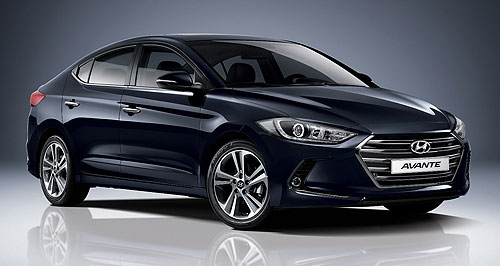Future models - Hyundai - ElantraHyundai’s new Elantra breaks coverSixth sense: The sixth-generation Elantra will be offered with a suite of active safety gear, depending on the variant. New-generation Hyundai Elantra scores extra safety gear and ‘mini-Genesis’ styling10 Sep 2015 HYUNDAI’S sixth-generation Elantra has been revealed in South Korea overnight, with the stylish small sedan bringing new active safety technology, a larger body and claimed improvements in ride quality and comfort. The all-new Elantra is expected to hit Australian showrooms in the first half of next year, following a motor show debut in Los Angeles in November. The latest version is 20mm longer and 25mm wider than before, which provides cabin space that is “comparable with that of the segment above”, according to Hyundai. While the new model carries a similar profile to the existing version, Hyundai has given it the ‘Fluidic Sculpture’ design treatment to bring it into line with other models in the range. The large chrome-heavy single-frame hexagonal grille was most recently seen on the Tucson SUV, while the modern slimline tail-lights are reminiscent of the Genesis luxury sedan, which is in keeping with Hyundai’s ‘Modern Premium’ brand direction. According to the South Korean car-maker, particular attention was paid to the design of the wheelarches to give the Elantra a more dynamic stance, while character lines and a “bold” rear bumper help it stand out from the pack. Inside, the Elantra again borrows from some of its larger, more expensive stablemates, with the dash design – in particular the placement of the large touchscreen and surrounding air vents – in keeping with the Sonata mid-sizer and the Genesis. Hyundai says it angled the dash and instruments 6.9 degrees towards the driver for a more cockpit-like feel, the controls have been repositioned for improved ergonomics, and extra soft-touch materials have been applied throughout. In terms of active safety, the new Elantra will feature autonomous emergency braking, high-beam assist, a blind-spot monitor, lane-change monitor and rear cross-traffic alert, but whether these are offered across the range or only on higher-spec models remains to be seen. Comfort and convenience functions include a ‘smart trunk’ that automatically opens the boot if the smart key is within a ‘sensing zone’ of the rear bumper for more than three seconds. In Korean guise, the Elantra will be offered with a choice of three four-cylinder powertrains, including a 97kW/161Nm 1.6-litre GDi petrol engine, a 100kW/300Nm 1.6-litre diesel, and a 110kW/179Nm 2.0-litre MPi Atkinson-cycle unit. While Hyundai Motor Company Australia says it is too early to confirm the local line-up, it is likely to follow the current model in offering one powertrain across a number of specification levels. Given the Australian market’s preference for higher-powered engines, the likeliest candidate is the 2.0-litre unit that will replace the current model’s 110kW/178Nm 1.8-litre four-cylinder. The new Elantra will be paired with a six-speed manual or six-speed automatic, with Hyundai’s new seven-speed dual-clutch transmission only available on the diesel variant internationally. Performance and fuel economy figures are yet to be revealed, but are expected to improve on the current model. The suspension comprises a MacPherson strut design up front and a coupled torsion beam axle at the rear, and GoAuto understands that Hyundai’s Australian tuning team has already been tweaking it to better suit our roads and conditions. Hyundai says improved ride quality and greater control have been achieved thanks to suspension layout changes, such as rear shock absorber and spring positioning, as well as structural enhancements to further strengthen the chassis. Tweaks to the ‘Motor Driven Power Steering’ have brought claims of improved steering feel, while the use of advanced high-strength steel – 32 per cent more than the outgoing model – has boosted rigidity and durability, according to Hyundai. Wheel choices range from 15-inch steel rims to 17-inch alloys on higher-grade variants. Engineers focused heavily on improving noise, vibration and harshness (NVH) levels of the Elantra, and on creating a more linear engine sound when accelerating. Re-engineered windscreen wipers, new rear-wheel guard materials and thicker door glass have helped cut wind noise and overall noise penetration into the cabin.  Read more19th of August 2015  LA show: Hyundai Elantra shapes upHyundai Elantra gets secret Australian shakedown ahead of Los Angeles show revealElantra pricingMotor industry news |
Click to shareHyundai modelsResearch Hyundai Elantra pricingMotor industry news |




















Facebook Twitter Instagram